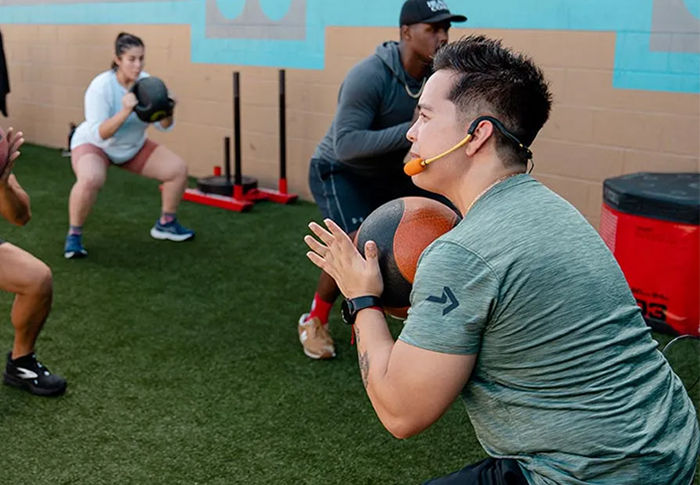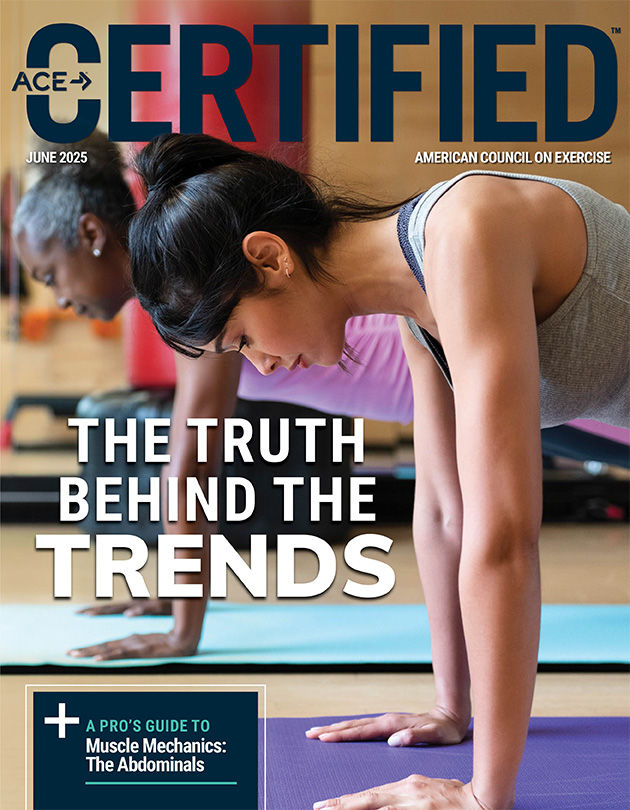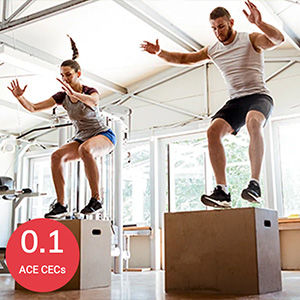Ask ACE: How to Maximize Your High-intensity Interval Training Workouts

In this series, ACE experts answer your health and exercise questions. From high-intensity interval training to youth fitness, you’ll find detailed answers to many of the questions that may come up in your work with clients. If you have questions you’d like to ask our experts, please email us at Christine.Ekeroth@acefitness.org.

The Expert: Lance C. Dalleck, PhD, is a professor of Exercise and Sport Science at Western Colorado University. His research interests include improving exercise performance and health outcomes through evidence-based practice, quantifying the energy expenditure of outdoor and non-traditional types of physical activity, and studying historical perspectives in health, fitness and exercise physiology. Dr. Dalleck is a member of the ACE Scientific Advisory Panel.
Q: I know the recommendation for high-intensity interval training (HIIT) workouts is two days per week, but how often can reduced-exertion high-intensity interval training (REHIT) workouts be performed per week?
Let’s rephrase this question. Is it better to perform REHIT more often than two days per week?
As is the case with so many fitness-related questions, the answer depends on the individual. As a health and exercise professional, you can use the ACE Mover Method to help clients identify the optimal frequency of REHIT workouts per week for their training programs. The ACE Mover Method is grounded in the belief that facilitating healthy lifestyle behaviors begins with empowering clients to take a personalized journey during which they achieve self-efficacy because the exercise professional or health coach practices empathy and trust, communication and collaboration. In particular, applying the ACE Mover Method can facilitate fitness- and health-behavior changes by designing, leading and modifying exercise programs based on each client’s current health and fitness status, needs and goals.
Next, let’s explore a few scenarios and answer the question of how often REHIT workouts can safely be performed each week. We’ll make sure to use an evidence-based approach because that is what sets ACE apart.
Scenario #1: The client’s goal is to combat the deleterious effects of excessive sedentary time and improve cardiometabolic health.
Prolonged sitting or sedentary behavior has been a growing epidemic and has been shown to adversely affect cardiovascular health. This includes a heightened susceptibility to metabolic syndrome (MetS) or the clustering of cardiovascular disease (CVD) risk and vascular dysfunction, which could ultimately lead to the development of atherosclerosis and subsequent heart disease and stroke. Recent studies have investigated exercise and non-exercise strategies delivered before or during a bout of sedentary behavior that could prevent adverse cardiovascular health. In fact, our team of researchers in the High Altitude Exercise Physiology Program at Western Colorado University investigated how the REHIT paradigm could be translated into a real-world workplace setting, wherein sedentary and physically inactive men and women at low-to-moderate CVD risk were recruited from a local university and hospital. A CAROLTM cycle ergometer unit was placed in each location to enable participants to perform REHIT during work hours on three to four days per week. Each CAROL REHIT session consisted of a two-minute warm-up, a 20-second sprint, a three-minute recovery, a second 20-second sprint and finally a three-minute cool-down. The total workout time was 8 minutes and 40 seconds.
Here are two key findings from this study:
- This intervention was superior in reducing MetS severity relative to the currently recommended exercise guideline of 150 minutes per week of moderate-intensity continuous training.
- We found excellent adherence, with the REHIT group completing 89% of the workouts.
Scenario #2: The client’s goal is to achieve optimal cardiorespiratory fitness in the most time-efficient manner.
Cardiorespiratory fitness is often referred to as the ultimate marker for heart health. Indeed, there are several landmark studies across the past several decades to underpin this statement:
- One of the very first studies to explore the connection between cardiorespiratory fitness and heart health was published in 1989. This hallmark paper reported that an inverse relationship existed between VO2max values and risk for CVD.
- In 2005, researchers reported findings from a study that examined the effect of cardiorespiratory fitness on risk of mortality from CVD in a cohort of men with diabetes within normal weight, overweight and obese categories. Both diabetes and obesity are associated with increased risk of mortality from CVD. For all weight categories (normal, overweight and obese), the risk of CVD mortality was shown to be two to four times higher among men with diabetes and low levels of cardiorespiratory fitness compared to those with moderate-to-high levels of cardiorespiratory fitness.
- Perhaps the strongest case to support cardiorespiratory fitness as the ultimate health outcome was made in a paper published in 2009. The author presented data to show that low cardiorespiratory fitness accounted for more overall deaths, including those from CVD, when compared to deaths that could be attributed to traditional risk factors, such as obesity, smoking, hypertension, high cholesterol and diabetes.
Given the body of evidence, it is not surprising that improved cardiorespiratory fitness remains a primary program goal for both health and exercise professionals and their clients. Moreover, given that perceived lack of time is commonly reported as a barrier to exercise, there is a need to identify time-efficient exercise interventions for improving cardiorespiratory fitness. REHIT is an evolution of high-intensity interval training (HIIT), which is seen as a time-saving alternative to traditional moderate-intensity cardiorespiratory exercise. While HIIT has been shown to have many of the same benefits of traditional cardiorespiratory exercise, the sessions typically last 30 minutes and are associated with high rates of perceived exertion, making them a less suitable option for individuals who are currently inactive and/or battling disease.
Apart from the REHIT interval duration (20 seconds) and number of interval repetitions (two), another overall strategy to optimize the time-efficiency of exercise sessions is to reduce the training frequency. For example, one study looked at the effect of training frequency (two, three or four sessions/week) on changes in cardiorespiratory fitness (i.e, VO2max) in response to six weeks of REHIT in inactive individuals.
Here are two key findings from this study:
- Changes in VO2max were not significantly different between the training frequency groups (two sessions/week: +10.2%; three sessions/week: +8.1%; four sessions per week: +7.3%).
- Researchers concluded that reducing REHIT training frequency from three or four to two sessions/week did not diminish improvements in the key health marker of VO2max.
Q: Is it possible to alternate traditional HIIT and resistance-training HIIT workouts in the same week?
Absolutely! As discussed above, three to four overall HIIT sessions (in the form of REHIT) have been shown to be well tolerated in individuals who have been previously inactive or sedentary. There is no reason to believe that integrating resistance-training HIIT workouts with traditional HIIT sessions throughout the week would elicit any differences in adherence or effectiveness. Moreover, our research demonstrated that the HIIT paradigm could be successfully applied to resistance exercise.
Here are three key findings from our study:
- Resistance-training HIIT was equally effective as (and in some instances more effective than) traditional resistance training at improving cardiometabolic health and muscular fitness.
- Resistance-training HIIT improved muscular fitness in a time-efficient manner, as it required less than half the time of traditional resistance training to achieve favorable adaptations. The average resistance-training HIIT session (including warm-up) was 20 minutes in duration. In contrast, the average traditional resistance-training session was 45 minutes in duration.
- Preliminary evidence suggests that resistance-training HIIT improves muscular fitness in a more rapid timeframe when compared to traditional resistance training. Indeed, for a few traditional resistance-training exercises (chest press and leg extension) there were no significant improvements in 1-RM and 5-RM values until after six weeks of training. By contrast, all one-repetition maximum (1-RM) and five-repetition maximum (5-RM) values improved significantly at three weeks in the resistance-training HIIT group. The achievement of such rapid results is important to highlight, as seeing these gains in only three weeks may improve the motivation levels of many clients during the early phase of a new exercise program, when they are typically most prone to frustration and dropout.
Q: How much recovery time is needed between workouts?
Here are a couple of recommendations based on the findings of ACE-sponsored research studies involving HIIT and REHIT:
- If performing two HIIT sessions per week, be sure to include 48 to 72 hours of recovery.
- If performing three to four HIIT sessions per week, these sessions should be scheduled on no more than two consecutive days followed by 48 to 72 hours of recovery prior to the subsequent HIIT session.
Q: What if my client gets burned out on HIIT workouts?
When it comes to preventing burnout, it is critical to familiarize yourself with factors most likely to explain dropout among clients completing HIIT workouts. On this point, there is an excellent meta-analysis that provides some great insight for health and exercise professionals.
Three key findings from the study:
- Dropout rates were significantly lower in cycling-based HIIT interventions when compared with studies using running/walking as the HIIT exercise modality.
- Longer HIIT session time and higher HIIT time per week predicted greater dropout.
- Exercise intensity was not associated with dropout.
The authors concluded that given the association between HIIT volume and dropouts, it was important to identify the minimally effective dose of practical HIIT for improving health status. This line of thinking is consistent with the discussion surrounding the optimal REHIT frequency from the first question in this Q&A article.
Q: How can I add some variety to help keep clients committed and engaged?
A: As the late Dr. Steven Blair, renowned exercise physiologist, once said, “the best exercise is the one that you enjoy doing.” When workouts start to lose their appeal, you can use the ACE Mover Method to help clients add some variety to help keep them on track and motivated to continue their workouts. Applying the ACE Mover Method starts with recognizing that a client-centered approach means believing individuals are the foremost experts on themselves. Applying the method means using powerful, open-ended questions and active listening to anchor every conversation. As such, rather than suggesting several options you can employ with your clients, a better approach is to ask your clients directly what they feel they need or want to do to maintain their commitment and engagement over the long-term.
Expand Your Knowledge
Total-body TabataTM HIIT Instructor Training
Total Body Tabata™ combines HIIT and the group fitness dynamic into a high-energy format, offering you a unique opportunity to provide the perfect mix of cardio and strength work. Focused on the exerciser, not the exercise, Total Body Tabata™ eliminates the stress of learning complex choreography or staying “on-beat” with music for your participants. Instead, it provides exercise regression and progression layers that enable all skill levels to achieve the proper intensity to improve fitness and health. Led by Total Body Tabata™ founders Autumn Skeel and Vicki Moen, this course teaches a modality that will enable you to lead engaging, time efficient classes aimed at getting your participants working at their peak effort while having fun doing it.
Programming the Ultimate HIIT Workout
High-intensity interval training (HIIT) is a popular workout that can be done anywhere. This efficient style of exercise programming also has a wide variety of health benefits, from enhancing cardiovascular fitness and body composition to improving blood profiles and cognitive function. Not to mention, it may boost confidence and motivation! Delve into the science behind HIIT so you can confidently program high-intensity workouts for clients of all types. In this video training, you’ll also uncover the versatility of this in-demand training and explore how HIIT can be applied outside (running, cycling, rowing, cross country skiing), inside (treadmill, elliptical, stair climber, stationary bike) and in a group environment using body weight or equipment.
More Articles
- Certified™: June 2025
Continuous Glucose Monitoring: What You and Your Clients Need to Know
Contributor
- Certified™: June 2025
Thriving as a Modern Health Coach: Essential Skills and Strategies for a Growing Profession
Contributor
- Certified™: June 2025
A Pro’s Guide to Muscle Mechanics: The Abdominals
Health and Fitness Expert








